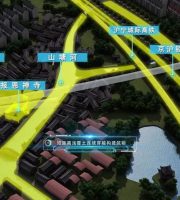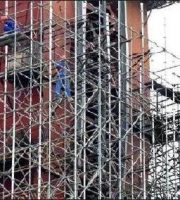Cement mortar floor is the most widely used floor, which is a traditional integral floor constructed directly on the cement mortar leveling layer of cast-in-place concrete cushion
.
In this paper, the well-known real estate company cement mortar floor engineering construction technology, comprehensive and detailed, for your reference
.
Construction process: cleaning the base course, snapping the elevation and the horizontal line of the surface course, marking (making ash cake) and punching reinforcement, preparing mortar, paving mortar, leveling and calendering, dividing joint, maintenance 1
.
Cleaning the base course, removing the sundries (floor ash, masonry mortar, etc.) on the ground by grinding machine, washing them with clean water after cleaning, and removing the garbage
.
[process key] the grinding should be thorough, especially for the corner of the room, and the floor ash and masonry mortar should be removed to reduce the floor hollowing
.
2 snap the elevation and horizontal line, place the building one meter line on the wall, and measure the elevation of the floor surface according to the building one meter line on the wall
.
[key points of working procedure] the one meter line should be accurately measured, and the one meter line should be rechecked, especially the error between each set of lines on the same floor and the elevation line of common parts
.
3
.
Paste plastering cake and punching bar (1) according to the horizontal line of surface layer elevation on the walls around the room, determine that the plastering thickness of the surface layer is not less than 20 mm, and then pull the horizontal line to start plastering cake
.
The horizontal and vertical spacing is 1.5-2.0 m, and the upper plane of the plastering cake is the surface layer elevation of the ground
.
[key points of process] the size of dot (ash cake) should not be too large, and should be controlled within 5 × 5cm
.
The mix proportion of plastering cake and punching bar is the same as that of plastering ground
.
(2) Check the elevation of the ash cake
.
[process key] the elevation of the ash cake shall be rechecked to ensure that the error of the distance between the ash cake elevation and the building’s one meter line is within the range of [- 2,2] mm
.
(3) If the room is large, in order to ensure the flatness of the overall surface course, it is necessary to carry out punching reinforcement
.
The cement mortar is laid between the ash cakes, and the width is the same as that of the ash cake
.
The wood trowel is used to make it flat with the upper surface of the ash cake
.
[process key] the surface of the punching bar shall be flat without bulge or depression, the bar shall not be too wide, and the strength of the cement mortar of the punching bar shall be consistent with that of the ground
.
(4) The management personnel of the team and construction unit shall check and check the elevation of the punched standard reinforcement to ensure that the ground leveling elevation is correct
.
[process key] if the elevation is not accurate, the unqualified punching bars should be reprocessed to prevent the overall ground elevation from being too high or too low after the later leveling
.
4
.
The mixing ratio of cement mortar should be 1:2 (cement: sand, volume ratio), the consistency should not be greater than 35mm, and the strength grade should not be lower than M15
.
[process key points] (1) Portland cement and ordinary portland cement should be used as cement, and their strength should not be less than po32.5; cement of different varieties and strength grades should not be mixed
.
(2) The sand used for cement mortar shall comply with the current industry standard “quality standard and inspection method of sand for ordinary concrete”
.
The sand shall be medium coarse sand
.
When stone chips are used, the particle size shall be 1 mm ~ 5 mm, and the mud content shall not be greater than 3%
.
(3) The volume ratio (strength grade) of cement mortar should meet the design requirements, and the volume ratio should be 1:2, and the thickness of cement mortar surface should not be less than 20 mm
.
5
.
Lay mortar (1) before the formal construction, the ground shall be fully wetted in advance
.
[process key] the ground should be well wetted
.
(2) Before laying mortar, evenly sweep plain cement slurry (water cement ratio 0.4 ~ 0.5) on the base course once
.
[process key] the plain cement slurry shall be spread all over the ground and wiped with scraping
.
It shall be uniform without dead angle to prevent hollowing in the later stage
.
(3) The cement mortar is spread over the plain cement slurry and paved with wooden poles
.
[process key] note that the virtual paving height of cement mortar should be 3 ~ 4mm higher than the ash cake, and the paving should be uniform
.
6 leveling and calendering (1) the first time: use calender to make the cement mortar more dense
.
[process key] calendering pressure should be uniform without dead angle
.
In the corner of the room, it should be noted that manual leveling is still needed after the calender leveling to prevent the flatness from meeting the requirements
.
(2) The second time: after the cement mortar has set and there is a little backwater, when people step on it and there is footprints but it does not sink, use the aluminum alloy scraping bar for scraping
.
According to the spot marking, it is fan-shaped with the punching bar
.
At this time, if it is lower than the punching bar, it is necessary to make up the mortar
.
[process key] the calendering time should be controlled accurately, not too early or too late to prevent hollowing in the later stage, and the process time and cross operation should be reasonably arranged
.
(3) The third time: Iron trowel leveling shall be carried out before the initial setting of cement mortar, from corner to large surface
.
[process key] the concave parts of aluminum alloy scraping should be repaired with mortar, and then leveled with iron trowel
.
7
.
After the initial setting of the dividing joint, the dividing joint shall be cut according to the functional section
.
The spacing of the dividing joint is generally 3 to 6 meters, and the dividing joint shall be set at the corner
.
[key points of process] the separation joint shall be straight and the depth shall be consistent
.
The width of the joint shall be 10 mm to 20 mm, and the depth shall run through the building surface
.
8
.
The curing shall be carried out 24 hours after the surface is polished, generally when there is no fingerprint on the surface with fingers
.
Depending on the temperature, the surface shall be watered or covered with film after watering, and the curing time shall not be less than 7 days
.
[process key] the maintenance time and frequency should be controlled, and corresponding maintenance schedule should be set
.
9
.
Check and accept the measured indexes of ground flatness, ground levelness and net height, mark the quality problem points such as hollowing and cracks, and rectify them
.
[key points of working procedure] record form of actual measurement of cement mortar floor engineering
.
Process control data (1) certificate and quality inspection report of various materials (2) actual measurement record of cement mortar floor Engineering (3) quality acceptance record of cement mortar floor inspection batch (4) water spraying (closed) transfer record quality standard 1 main control item (1) the thickness of cement mortar surface should meet the design requirements
.
(2) Portland cement and ordinary portland cement should be used as cement, and cement of different varieties and strength grades should not be mixed; sand should be medium coarse sand
.
(3) The volume ratio (strength grade) of cement mortar shall meet the design requirements
.
(4) For the cement mortar floor with drainage requirements, the slope direction shall be correct and the drainage shall be unobstructed; the waterproof cement mortar surface shall not leak
.
(5) The surface layer shall be firmly combined with the next layer without hollowing and cracking
.
2 general items (1) the slope of the surface course shall meet the design requirements, and there shall be no backflush and ponding
.
(2) The surface of the surface course shall be clean without cracks, peeling, pitting, sanding, etc
.
(3) The allowable deviation of cement mortar surface course shall comply with relevant regulations, surface flatness [0, 4mm], ground levelness [0, 10mm]
.
Note 1 ground hollowing prevention and control note (1) the base surface is not clean, mud, lime, mortar, slurry and other debris become the isolation layer, affect the surface layer firmly combined, easy to form hollowing
.
(2) If the bottom layer is not watered or not watered enough, the moisture of the mortar is quickly absorbed, which greatly reduces the mortar strength and adhesion, and is easy to form hollowing
.
(3) If the plain cement slurry is used as the binding layer, if it is painted too early, and the surface layer is paved after it has been dried and hardened, it will not only have no cohesive force, but also become an isolation layer; when the slurry sweeping method is used, the dry cement is not easy to spread evenly, and the amount of watering is improper, which will easily cause dry ash layer, ponding pit, and hollowing
.
(4) In case of ground ponding, the water cement ratio of the paved surface layer increases in the ponding part, which affects the bonding with the bottom layer and is easy to form hollowing
.
(5) The ash cake (or standard reinforcement) is not knocked out, because the material used in the ash cake (or standard reinforcement) is different from the ground leveling, the shrinkage is inconsistent, and it is easy to produce hollowing.
.


